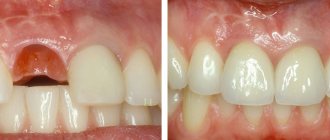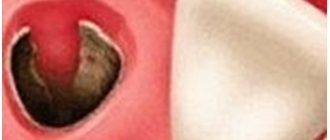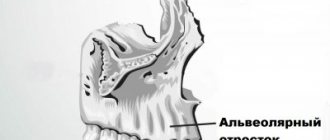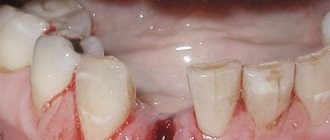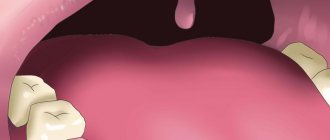Preservation of the hole - a necessity or a new trend?
Preservation of the socket - filling the cavity formed after tooth extraction with osteogenic material - is a very important component of dental treatment after tooth extraction.
This technique completely prevents bone resorption, which is known to be 25% already in the first year, which means that within 3 years the loss of bone volume can be 60%.
Preservation of the socket not only stops this process, but also preserves the gingival contour without gaps and prepares the gingival bone for future unhindered implant installation.
It is important that conservation ensures the correct load on the bone tissue, which means that at the time of implantation the condition of the bone will be exactly what is necessary for installing the implant without prior bone grafting.
Thus, preserving the socket after tooth extraction will not only save the patient from additional bone-building surgery, but will also save a considerable amount, because bone grafting is not the cheapest dental operation.
What happens to the tooth socket after extraction?
A more or less detailed answer to this question is in the corresponding article; we also touched on it in the post about immediate implantation. Therefore, within the framework of this essay, I will rather talk about complications after extraction and how they affect the tooth socket.
Let's say we extracted a tooth very carefully. The hole filled with a blood clot, which became a kind of bandage, isolating the bone tissue from the external environment. It’s good if the hole is small and the blood clot is fixed normally. It’s good if the patient did not resort to traditional methods of perverting treatment, namely, did not try to wash the hole, did not stick a clove of garlic into it, and did not even watch Malysheva on TV, but followed all the recommendations. In this case, he is in almost no danger.
But if the hole is large, and there is a huge cyst or granuloma in the area of the root apex. If the tooth was removed in a state of acute inflammation. Or, for example, from the apex of the root to the bottom of the maxillary sinus, the thickness of the bone tissue does not exceed 0.3-0.5 mm. Or the patient is a very thin, diet-exhausted girl with perpetually low, almost critical blood pressure. Then, friends, there is a risk of alveolitis - inflammation of the tooth socket. And this disease, not only causes a lot of unpleasant sensations, significantly accelerates the resorption of the bone tissue surrounding the hole.
What to do in such cases?
If implantation is not planned, is socket preservation necessary?
If implantation is not planned, preservation of the hole will still be the right decision. This simple procedure will, at a minimum, speed up the healing process of the hole and completely prevent all sorts of risks of complications and infection, and at most - taking into account the fact that you should never say “never” - it will be very useful when you need to install an implant. In other words, this is a real opportunity to give the patient choice.
Preservation of the socket after tooth extraction is recommended for anyone who needs to install an implant in place of a missing tooth. This procedure will help preserve the volume of jaw bone and the natural contours of the alveolar process, and subsequently avoid alveolar bone augmentation for implantation.
There are practically no contraindications
except for acute pain. But even in this case, everything is individual, taking into account medical indications corresponding to the specific clinical situation.
Advantages of socket preservation after tooth extraction
- Minimum healing time for a socket after tooth extraction.
- Preventing infection from entering the socket.
- Preservation of bone tissue.
- The aesthetic appearance of the gingival contour is a guarantee of aesthetic prosthetics.
- Possibility to install an implant 1 month after tooth extraction.
- No need for augmentation.
The advantages of the procedure are obvious, which is why preservation of the socket after tooth extraction is very popular in dental dentistry.
100% guarantee of successful surgery - high-quality osteoplastic materials.
Materials for hole preservation Genoss (South Korea)
— the best bone replacement materials for socket preservation today.
Advantages of preserving the socket of an extracted tooth
- excellent preservation of bone tissue integrity;
- no need for complex and expensive procedures for artificial bone augmentation;
- protecting the socket from infection throughout the healing period;
- an ideal method for working with bone areas on the upper jaw located adjacent to the maxillary sinuses (the risk of injury to the air cavities during certain types of bone augmentation is eliminated).
Genoss bone replacement materials
Genoss are bone substitutes of the highest quality, which have been successfully used in dentistry for a very long time.
When are Genoss osteoplastic materials used?
Genoss have proven themselves to be excellent in filling sockets at the site of an extracted tooth, dental implantation, bone ridge plastic surgery, filling cystic hilar cavities, in the case of post-osteotomy techniques, in restoring periodontal tissues, and filling cavities during sinus lifting.
Benefits of Genoss
- One hundred percent biocompatibility with tissues of the human body.
- High resorbability.
- Rapid tissue healing.
- Improvement of hemostasis.
- Easy to use.
Prosthetics and implantation against bone loss
Since bone atrophy is directly related to loss of load and missing teeth, patients strive to restore their dentition faster. Modern dentistry offers:
- dental prosthetics;
- dental implantation.
Prosthetics after tooth extraction
The easiest way to restore teeth is with a bridge or removable denture. Among the advantages of orthopedic structures:
- ease of treatment;
- affordable price.
There is only one serious drawback - ongoing bone resorption. Prosthetics load the supporting healthy teeth, and the bone at the site of the extracted tooth still remains inactive. The prosthesis lies on the gum, presses tightly against it, but does not provide the necessary pressure.
As a result, atrophy develops further. A decrease in bone volume entails subsidence of the gums, the prosthesis fits worse and worse - relining and installation of a new structure are required.
Implantation after tooth extraction
Dental implantation completely solves the problem of tissue atrophy. The implanted implant completely replaces the tooth root and takes over all its functions. The tissue receives the necessary load: blood supply is maintained in it, and mandatory metabolic processes take place.
The dentist-implantologist selects the implantation technique based on the indications, capabilities and condition of the bone. Most popular protocols:
- Simultaneous or one-stage implantation. It is carried out at the time of tooth extraction. The doctor implants the implant into the hole, after making sure there are no contraindications. Further procedures depend on the agreed treatment method. Either the implant is left until complete healing and then loaded with a crown, or the crown is immediately attached to the implanted dental implant using the immediate loading protocol.
- Classic implantation. It is selected for significant atrophy and involves preliminary restoration of bone tissue. The doctor performs osteoplasty and waits for complete healing (4-6 months). Afterwards, the implant is installed and the implantation of the artificial root is monitored (3-6 months). The last stage of treatment is fixation of the crown.
Proper oral care after removal.
It is important to follow your dentist's advice regarding oral care after the extraction procedure. Your doctor will explain to you in detail how to prevent pain, discomfort and inflammation. After recovery, you can contact us for implantation and prosthetics. Our qualified dentists will help restore the beauty and naturalness of your smile using the most modern prosthetic methods.
Tooth extraction RUB 3,500.
Tooth extraction (complicated) RUB 5,000.
Tooth extraction with bone grafting RUB 15,000.
Removal of an impacted tooth RUB 15,000.
Curettage of tooth socket RUB 1,000.
Resection of the root apex 10,000 rub.
Increasing the anatomical length of a tooth RUB 10,000.
Excision of the hood (pericoronitis) RUB 3,000.
Lip frenuloplasty RUB 3,000.
Tongue frenuloplasty RUB 2,500.
Gum correction with laser RUB 2,500.
Laser gum retraction (1 tooth) 500 rub.
Treatment of alveolitis (curettage, drug treatment) RUB 1,500.
Open curettage (1 tooth) 1500 rub.
Opening an abscess 2000 rub.
Price
According to the classifier of surgical interventions in the oral cavity, condomation is not among the standard surgical interventions and this, of course, affects the cost of its implementation. In addition, the price of osteoplastic materials and related products is quite high. Some materials are used only in conjunction with a special membrane to avoid ingrowth of soft tissue into the alveolar socket. The price is also affected by the method of tooth extraction. Removal of a tooth or tooth root is sometimes still a traumatic procedure, leading to direct loss of alveolar bone and soft tissue. With atraumatic removal, the alveolar bone is preserved in a larger volume, which reduces the final cost of the operation.
Preservation of the socket after tooth extraction is an important procedure when planning the installation of an implant. Timely preservation of the socket will allow you to preserve such valuable bone tissue and avoid a much more complex and expensive operation to build it up - augmentation, as well as significantly reduce the overall treatment time. The cost of preserving the natural contours of the alveolar socket pays off, because you thereby provide the teeth surrounding it with a reliable position, and as a result, during implantation, you get an imitation of the removed tooth root. This procedure applies even to those patients who do not intend to restore or replace a lost tooth with an implant, because in this case the gingival contour will have the most aesthetic appearance, without failures, and will allow for the most aesthetic bridge prosthetics. Therefore, reservation is gaining increasing popularity in dental dentistry.
According to antiplagiat.ru, the uniqueness of the text as of October 16, 2018 is 90.3%.
Key words, tags: tooth extraction, wisdom tooth, bone tissue, implant installation, augmentation, implantation.
*Images: Astra Tech Dentsply Implants; Principles of hard tessue regeneration and implant therapy.
Resorption period and time for removal
In some cases, the doctor recommends not waiting for complete resorption of the thread and removing it from the tissues before the decomposition process begins. Usually, any sutures, including insoluble ones, are removed from the gums on the 7th-8th day. Therefore, after the procedure, you need to check with the dentist when to come for a follow-up appointment.
At the control visit, the doctor assesses the degree of healing, visually examines the tissue for the presence of swelling, redness, and asks the patient whether he is bothered by pain. If everything is normal, the stitches are removed.
If the regenerative processes in the postoperative field have not yet been completed, the period of wearing sutures is extended by 2-3 days.
During the process of removing the suture material, the patient may experience mild pain and discomfort. If the patient’s pain threshold is greatly reduced, before the procedure the gums are treated with surface anesthesia (Lidocaine or Novocaine in the form of a spray).
The process of pulling out seams consists of several stages:
- treating the patient's oral cavity with an antiseptic;
- assessment of the condition of the oral mucosa for the presence of pus in the wound area, swelling, redness;
- cutting the thread in several places of a continuous seam with special dental scissors (with intermittent fastening, each stitch is cut);
- pulling out thread fragments from tissues with tweezers;
- checking the quality of scar formation on the wound.
At the end of the procedure, the entire oral cavity is treated with an antibacterial solution.
Hole preservation procedure
Preservation of the socket of an extracted tooth is a fairly simple and effective operation for preserving bone volume and maximizing the preservation of the natural contours of the alveolar socket. This surgical procedure is performed under local anesthesia and does not pose any risk.
Usually the operation is carried out in several stages:
- treatment of the hole after tooth extraction with special antiseptic compounds;
- installation of a membrane to protect the vestibular wall;
- filling the socket cavity with granular bone-forming substance;
- fixation of the operating surface by tensioning the free edges of the connective tissue;
- applying a bandage or a thin, neat suture.
Complete healing of the postoperative area occurs by the fourth week, and after 3–4 months, in some cases 6 months, if the condition is satisfactory, this area can be used to install an implant.
In what cases is tooth extraction necessary?
Our specialists always strive to preserve the teeth of their patients. Removal is carried out only in the following cases:
- Tooth fracture
.
- Difficulties with wisdom teeth
. Removal is necessary if wisdom teeth shift and deform the dentition, damage the soft tissues of the cheeks during chewing and interfere with a full life in general.
- Deformation of the dentition
. If there is an incorrect bite and if there is deformation of the dentition, the removal of interfering teeth is recommended on the recommendation of an orthodontist.
- The occurrence of dental diseases
. These include purulent periostitis, sinusitis of the maxillary sinuses, etc.
- If it is not possible to carry out prosthetics and install a crown
.
In some situations, resorting to such a radical treatment method is not recommended. This procedure should not be carried out in case of exacerbation of mental illnesses and chronic heart diseases. Contraindications are also certain periods of pregnancy and infectious diseases in the acute phase. In these cases, visiting the dental office should be postponed.
Make an appointment
How is the procedure carried out?
Tooth extraction at the Doctor Bon clinic is carried out as carefully and carefully as possible. Our specialists will do everything to ensure that this procedure becomes:
— Painless
. The dentist will carefully administer an anesthetic to the patient.
— Fast
. Our doctors use special surgical or classical instruments, taking into account the specifics of the upcoming procedure.
— Has no negative consequences
. The doctor will provide detailed information about the necessary procedures to speed up the healing and recovery process
Following important rules of oral hygiene after a dental procedure will help you avoid unpleasant painful sensations by speeding up the healing of your gums.
